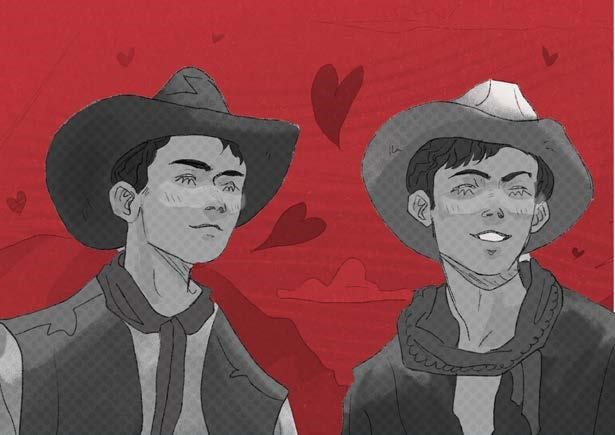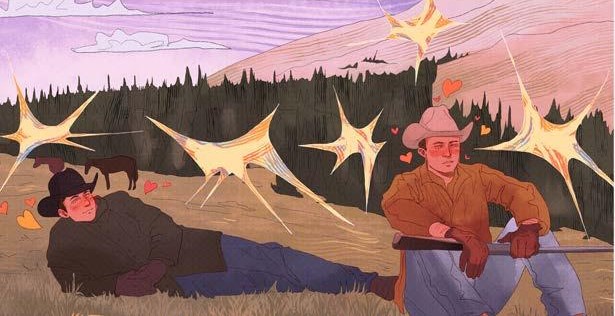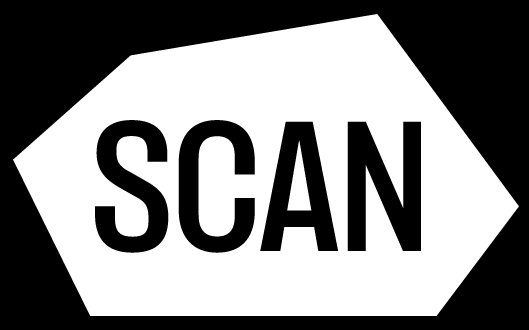The Wild History Of Gays In Westerns
Written by DJ Shaw
Illustrated by Anna Rhode

The Wild West has always been an understated “DL” destination for Hollywood. For many directors and writers, the dots just connect themselves. I mean how do you argue that groups of men spending years alone with nothing to do but count the tumbleweeds and shove their guns in each other’s faces isn’t at least a 7 on the homoerotic scale? The allure to combine a genre built on exploring the masculine psyche, that regularly features themes of conquest and loneliness, is just too tempting not to inject with a certain queer masculine fervor.
However, the most fascinating aspect of the queer cowboys of cinema is how they chronicle the story of the queer everyman in cinema. Most of these films can be used as windows into how audiences and filmmakers thought gay men should be depicted. And following this timeline will take you down a dusty trail of highs, lows, but most importantly fully through Western filmography.
”The Gay Buckaroo” (1932)
Our starting point is The Gay Buckaroo (1932), which is of interest note due to it popping out of the closet about 2-3 years right before the Hays Code. The Hays Code was essentially a set of rules of things you could and could not have on screen, and guy-on-guy action was a definite no. And you can feel that tension in the film. Though it wasn’t illegal yet to have a character be gay, the trend at the time was sort of a proto-GBF. They like makeup, hair, and dancing, and though they are romantically paired with women, they feel and act more like male best friends. Showing little to no sexual attraction to their female partners. And that’s true for this film here. He’s gay not because he wants men, but because he acts queer. He acts differently than how men traditionally act in social circumstances. Which at this point, is peek comedy.
”Red River” (1948)
So now we’re at a point where the hays code is very much so in effect. However, filmmakers were determined to override these rules. Introducing Red River (1948) to the stage, which almost seems to be gleeful about its homoerotic subtext. And we’re using subtext very generously here. This is the film most remembered for a scene where the two “trade guns” and comment on how “firm” they feel. Here we can see a real ironic portrayal of the gay cowboy—still showing the resemblance of the past with a comedic edge but now allowed to express attraction. Almost taking delight in the idea that yeah, cowboys are people too, even when they’re gay.
”Lonesome Cowboys” (1968)
We’ve now made it to where the hays code is in the process of breaking. As such, this year was huge for “Gays Doing Crimes” films. Lonesome Cowboys revels in its depictions of queer men. The entire point of the movie is that they are sad queer men. Warhol refused to allow censored viewings, even when authorities got involved. Finally showing a push away from the subtext.
It’s also transitional in that from this point onward we really lean into the loneliness of the queer cowboy. There’s a serious Oliver Twist quality to the way their relationship forms. The film strives away from presenting their lives as heroic and instead posits their lives as hazy trips. The film takes on a documentary-esque style, but you never get a sense of where they know where they’re going. Showcasing the void of being on the outskirts of society. The camera exists as the eye of patriarchal men. And its subjects both yearn to be seen and unseen by its gaze.
“Zacharia” (1971)
Zachariah: the self-titled “First Electric Western.” Electric how though? Well, the life of the cowboy is paralleled with the archetype of the 70s rockstar. Our cowboys here are very brazen about their lifestyle. Toting by the seam of their pants, getting caught in scraps, and having lots of adventures with banjos.
Their world however doesn’t treat them like rockstars. The local cowboys view them as the lesser runs of society, not being able to fit into the ranks. Zachariah is even called the “F” slur by a bar local. Showing the queerness in these cowboys is less erotic and more about status. Don’t get me wrong, it’s still erotic. Zachariah and his friend Matthew literally ride off into the sunset. But that in itself is performative, only now in a direction they feel comfortable in.
”Zorro: The Gay Blade” (1981)
It’s truly remarkable that it’s taken us this long to reach a film that so emphatically puts the camp in campsite. Everything was heightened in the 80s. The people wanted theatrics, and the gays were ready to give it to them. We see much grander sets that walk the line between being convincing and feeling like you’re watching a recorded play. The actors also give their absolute all which makes the film very quotable. Applying that here, this film is a parody of a popular fictional character in the western canon: Zorro. But by giving him a gay twin brother the film does two things. For one it asks the question why not? If Zorro himself is fictional why can’t anyone add to Zorro lore? Why must certain characters be pigeon held to the heteronormative lens? Leading to, why can’t you view the world as gay? Because although there is one “gay” brother, the film pokes fun at the fact everyone here feels very queer. But the world itself has been flipped to be homonormative, its eye assumes naturally that we would read the world as queer. And there’s true power in the reclaiming taking place here.
”Brokeback Mountain” (2005)
No conversation of the queer cowboy can be complete without acknowledging the elephant in the room: Brokeback Mountain (2005). This film is by far not only the biggest queer cowboy picture on this list but also arguably the biggest male-onmale love story put to screen. For many, if you ask them to name a gay movie, this is their answer. Which highlights the power the queer cowboy has in discussing gay identities on film.
We’ve returned to a focus on the loneliness of our cowboys, but now full circle, where instead of it being them against the world, it’s the world against them. Our two men, Ennis and Jack, have undeniable chemistry. It’s something the people around them can see, and we all do as well. However, the world would never allow their love. Communicated so beautifully by the relationship between wide and close-ups, there is a defying echo between the two. Leading to a lifelong push and pull, where neither or only one is willing to admit their yearning for the other. Especially Ennis, who when finally willing to fall in love, is greeted with the news of Jack’s death.
”Power of the Dog” (2021)
The most recent explosion into the cowboy canon was The Power of the Dog (2021), released during the pandemic. And this is a Covid movie with a capital C. Again, hitting on the loneliness, we see the immediate impact Brokeback Mountain had. Wide shots show figures in landscapes, a family with a closeted patriarch, and a romance slowly blossoming in the shadows of society.
The difference here is that there isn’t the same shock element as Brokeback Mountain. It’s been almost 20 years, and the film is aware of this. So in contrast, this is our first movie where the gay characters are “closeted” but not struggling with their sexuality or hiding their sexuality. More in the Zachariah sense.
They are the outsiders, the grifters. These characters spend hours alone performing tasks that help them understand their thoughts better. They don’t have an identity crisis as much as they have a location crisis. They know who they are, and they know what they want, but feel trapped and like they can’t have that.
No longer is his queerness in the shadows, but rather a vessel to explore other aspects of himself. The fact that he’s gay is no longer the story, but now an aspect of his story. Which is crazy when you look back at how far we’ve truly come.

